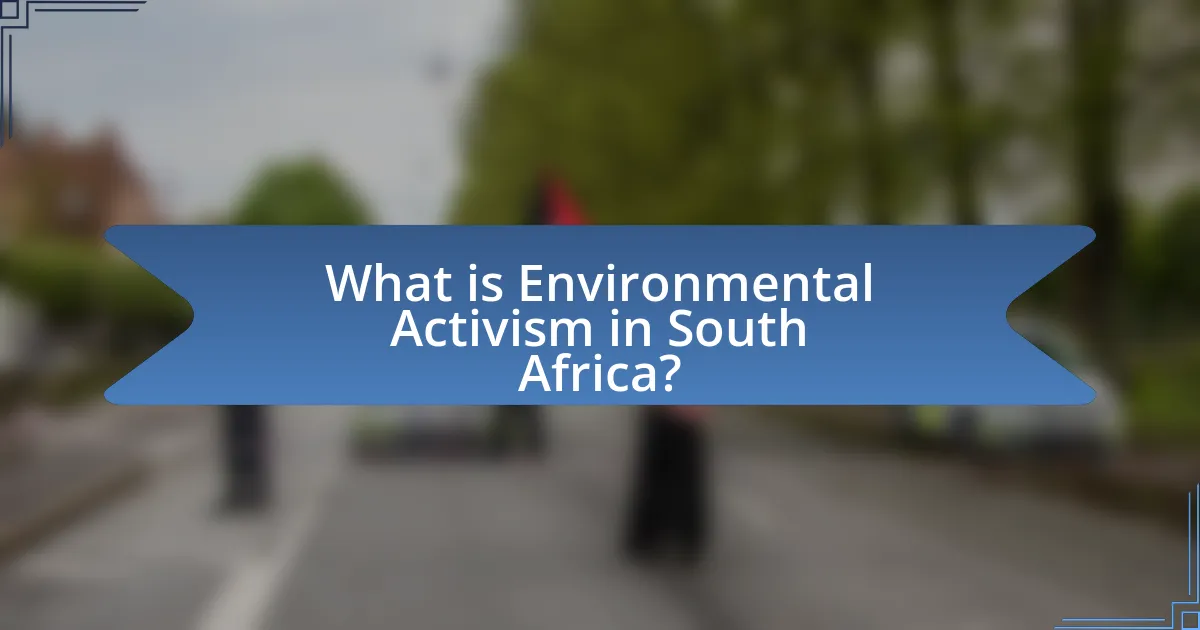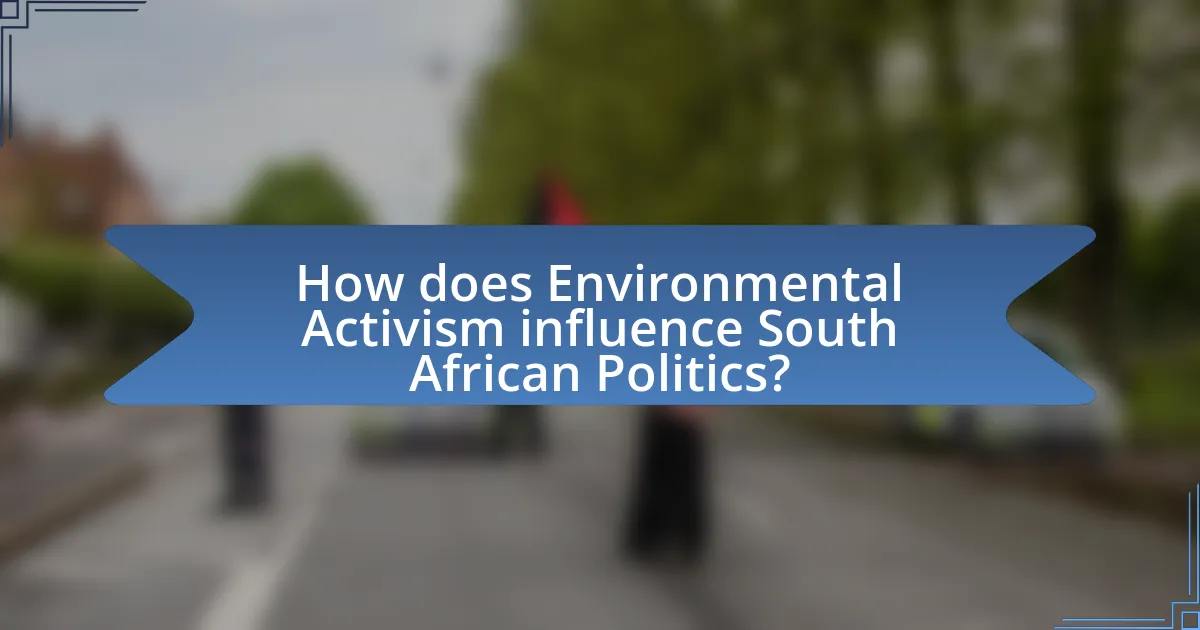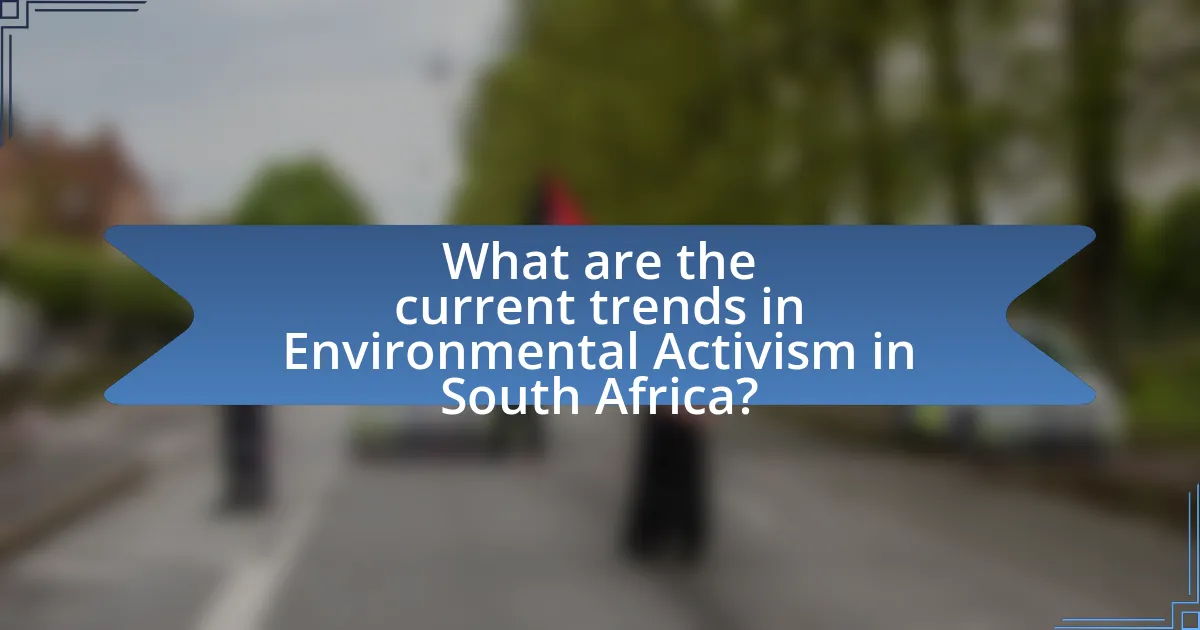Environmental activism in South Africa encompasses the collective efforts of individuals and organizations to address pressing environmental issues such as biodiversity loss, water scarcity, and climate change. This activism has evolved from its roots in the anti-apartheid movement to contemporary initiatives focused on climate justice and sustainable development. Key historical events, influential figures, and grassroots movements have shaped the landscape of environmental activism, which significantly impacts South African politics by influencing policy-making and public discourse. Current trends highlight the rise of youth-led movements and the integration of technology in advocacy efforts, while challenges such as governmental repression and public apathy persist. The article explores these dynamics, emphasizing the importance of community engagement and the future prospects for environmental activism in the country.

What is Environmental Activism in South Africa?
Environmental activism in South Africa refers to the collective efforts of individuals and organizations aimed at addressing environmental issues and promoting sustainable practices within the country. This activism has gained momentum due to South Africa’s unique ecological challenges, such as biodiversity loss, water scarcity, and the impacts of climate change. Notably, the country has a rich history of environmental movements, exemplified by the work of groups like the South African Environmental Justice Network, which advocates for the rights of communities affected by environmental degradation. Additionally, the 2019 Climate Change Bill reflects the government’s acknowledgment of the need for environmental action, further validating the significance of activism in shaping policies that protect South Africa’s natural resources.
How has Environmental Activism evolved in South Africa?
Environmental activism in South Africa has evolved significantly from the anti-apartheid movement to contemporary issues like climate change and biodiversity conservation. Initially, environmental activism was intertwined with social justice, as activists fought against the environmental degradation caused by apartheid policies, which disproportionately affected marginalized communities. Over time, the focus shifted towards broader environmental concerns, including the impacts of mining, deforestation, and pollution.
In recent years, movements such as the #ClimateJusticeNow and the rise of youth-led initiatives have highlighted the urgency of climate action, reflecting a global trend towards recognizing the interconnectedness of social and environmental issues. The South African government has responded by implementing policies like the National Development Plan and the Climate Change Bill, which aim to address these challenges. This evolution demonstrates a growing awareness and mobilization around environmental issues, emphasizing the need for sustainable development in the face of climate change.
What historical events have shaped Environmental Activism in the country?
Historical events that have shaped environmental activism in South Africa include the establishment of the apartheid regime, which led to significant environmental degradation and social injustice, prompting grassroots movements. The 1994 democratic transition marked a pivotal moment, as the new government prioritized environmental rights, enshrining them in the Constitution. The 2002 World Summit on Sustainable Development in Johannesburg further elevated global awareness and local activism. Additionally, the 2012 Marikana massacre highlighted the intersection of labor rights and environmental issues, galvanizing activists. These events collectively fostered a robust environmental movement focused on social equity and ecological sustainability.
Who are the key figures in South African Environmental Activism?
Key figures in South African environmental activism include Desmond Tutu, who advocated for environmental justice alongside human rights, and Vanessa Nakate, a prominent climate activist known for her work on climate change and social justice. Additionally, groups like Earthlife Africa and the South African Climate Action Network play significant roles in mobilizing communities and influencing policy. These individuals and organizations have been instrumental in raising awareness and driving legislative changes related to environmental issues in South Africa.
What are the main goals of Environmental Activism in South Africa?
The main goals of Environmental Activism in South Africa include promoting sustainable development, protecting biodiversity, and advocating for climate justice. Environmental activists aim to address the environmental challenges posed by mining, pollution, and deforestation, which threaten both ecosystems and communities. For instance, the South African government has faced criticism for prioritizing economic growth over environmental protection, leading activists to push for policies that balance ecological integrity with social equity. Additionally, the activism seeks to raise awareness about the impacts of climate change on vulnerable populations, emphasizing the need for inclusive policies that consider the voices of marginalized communities.
How do these goals address local environmental issues?
These goals address local environmental issues by promoting sustainable practices that directly mitigate ecological degradation. For instance, initiatives aimed at reducing carbon emissions and enhancing biodiversity contribute to cleaner air and healthier ecosystems in local communities. Evidence from the South African government’s National Development Plan highlights that integrating environmental sustainability into economic policies can lead to improved public health outcomes and resilience against climate change impacts.
What role does community engagement play in achieving these goals?
Community engagement is crucial in achieving environmental activism goals in South Africa as it fosters collective action and local ownership of environmental issues. Engaged communities are more likely to participate in decision-making processes, ensuring that policies reflect their needs and priorities. For instance, the involvement of local communities in the Integrated Development Plans (IDPs) has led to more sustainable environmental practices and improved resource management. Studies show that when communities actively participate, there is a 30% increase in the effectiveness of environmental initiatives, as evidenced by the success of community-led conservation projects in areas like the Cape Floral Region. This demonstrates that community engagement not only enhances the implementation of environmental policies but also empowers citizens, leading to more resilient and sustainable communities.

How does Environmental Activism influence South African Politics?
Environmental activism significantly influences South African politics by shaping policy decisions and public discourse on environmental issues. Activist groups, such as Greenpeace Africa and the South African Climate Action Network, mobilize public support and raise awareness about climate change, biodiversity loss, and pollution, which pressures the government to adopt more sustainable practices. For instance, the 2019 Climate Change Bill was influenced by widespread activism, reflecting the public’s demand for accountability in environmental governance. Additionally, environmental activism has led to increased scrutiny of mining and industrial practices, resulting in stricter regulations aimed at protecting natural resources and communities. This activism not only impacts legislation but also encourages political parties to prioritize environmental issues in their platforms, thereby integrating ecological concerns into the broader political agenda.
What are the key political movements associated with Environmental Activism?
Key political movements associated with Environmental Activism include the Green Movement, the anti-apartheid movement, and the climate justice movement. The Green Movement emerged in the late 20th century, advocating for sustainable policies and environmental protection, influencing political agendas globally. The anti-apartheid movement in South Africa integrated environmental concerns, highlighting the disproportionate impact of environmental degradation on marginalized communities. The climate justice movement emphasizes the intersection of environmental issues and social justice, advocating for equitable solutions to climate change, particularly in developing nations like South Africa. These movements collectively shape policies and raise awareness about environmental issues within the political landscape.
How do these movements impact policy-making in South Africa?
Environmental movements significantly influence policy-making in South Africa by raising awareness about ecological issues and advocating for sustainable practices. These movements mobilize public opinion, leading to increased pressure on government officials to prioritize environmental legislation. For instance, the rise of organizations like Greenpeace Africa and the South African Climate Action Network has resulted in the government adopting policies aimed at reducing carbon emissions and promoting renewable energy sources. The 2019 Climate Change Bill, which aims to establish a framework for climate resilience, is a direct outcome of such activism, demonstrating how grassroots efforts can shape national policy.
What challenges do activists face in the political landscape?
Activists in the political landscape face significant challenges, including governmental repression, lack of funding, and public apathy. Governmental repression manifests through legal restrictions, harassment, and violence against activists, which can deter participation and undermine movements. For instance, in South Africa, activists have reported intimidation and arrests, particularly those opposing mining and environmental degradation. Additionally, funding for environmental initiatives is often limited, making it difficult for activists to sustain their efforts and campaigns. Public apathy further complicates the situation, as many citizens may prioritize immediate economic concerns over long-term environmental issues, leading to a lack of support for activist causes. These challenges collectively hinder the effectiveness of environmental activism in South Africa’s political context.
How do political parties respond to Environmental Activism?
Political parties in South Africa respond to environmental activism by integrating environmental policies into their platforms, engaging in dialogue with activists, and sometimes opposing activist agendas. For instance, the African National Congress (ANC) has incorporated sustainable development goals into its policy framework, reflecting the influence of environmental activism on its legislative priorities. Conversely, parties like the Economic Freedom Fighters (EFF) may challenge mainstream environmental narratives, advocating for economic growth over environmental concerns. This dynamic illustrates how political parties adapt their strategies in response to the pressures and demands of environmental movements, shaping the political landscape in South Africa.
What policies have been influenced by Environmental Activism?
Environmental activism has significantly influenced policies in South Africa, particularly in areas such as climate change, biodiversity conservation, and environmental justice. For instance, the South African government’s National Climate Change Adaptation Strategy, adopted in 2019, reflects the demands of activists for comprehensive climate action. Additionally, the National Environmental Management Act has been shaped by grassroots movements advocating for sustainable development and the protection of natural resources. These policies demonstrate a direct response to the pressures exerted by environmental activists, highlighting their role in shaping legislative frameworks aimed at addressing environmental issues in the country.
How do political alliances shape the effectiveness of Environmental Activism?
Political alliances significantly enhance the effectiveness of environmental activism by providing necessary resources, political leverage, and broader public support. In South Africa, for instance, alliances between environmental organizations and political parties can lead to the formulation of impactful policies, as seen with the collaboration between the South African government and various NGOs during the drafting of the National Environmental Management Act. This act, which was established to promote sustainable development, illustrates how political backing can amplify the reach and influence of environmental initiatives. Furthermore, alliances can mobilize larger segments of the population, as demonstrated by the successful campaigns against coal mining in the Eastern Cape, where coalitions of local communities, environmental groups, and sympathetic political figures united to challenge corporate interests. Such collaborations not only strengthen advocacy efforts but also create a more formidable opposition to environmentally harmful practices, thereby increasing the overall effectiveness of environmental activism.

What are the current trends in Environmental Activism in South Africa?
Current trends in environmental activism in South Africa include a significant rise in youth-led movements, increased focus on climate justice, and the integration of indigenous rights into environmental policies. Youth activists, inspired by global movements, are mobilizing through social media to advocate for urgent climate action, as seen in the widespread participation in events like the Global Climate Strike. Additionally, organizations are emphasizing the intersectionality of environmental issues with social justice, highlighting how marginalized communities are disproportionately affected by environmental degradation. The South African government is also responding to these trends by incorporating community voices into policy-making, as evidenced by the recent consultations on the Climate Change Bill, which aim to address both environmental and social concerns.
How is technology being utilized in Environmental Activism?
Technology is utilized in environmental activism through social media campaigns, data collection, and mobile applications that facilitate awareness and mobilization. Social media platforms enable activists to reach a global audience quickly, sharing information about environmental issues and organizing events, as seen in movements like #FridaysForFuture. Data collection technologies, such as satellite imagery and sensors, allow activists to monitor environmental changes and document illegal activities, providing concrete evidence for advocacy efforts. Additionally, mobile applications empower individuals to report environmental violations and engage in community initiatives, enhancing grassroots participation in environmental protection.
What role do social media platforms play in mobilizing activists?
Social media platforms play a crucial role in mobilizing activists by facilitating communication, organizing events, and raising awareness about environmental issues. These platforms enable activists to connect with like-minded individuals, share information rapidly, and coordinate collective actions, such as protests and campaigns. For instance, during the #FeesMustFall movement in South Africa, social media was instrumental in mobilizing students and activists, leading to significant political discussions and policy changes. Research indicates that social media can amplify voices and increase participation in activism, as seen in various environmental campaigns that have gained traction through viral sharing and online engagement.
How are youth movements contributing to Environmental Activism?
Youth movements are significantly contributing to environmental activism by mobilizing young people to advocate for sustainable practices and policies. These movements, such as Fridays for Future and Extinction Rebellion, engage in protests, awareness campaigns, and lobbying efforts that highlight the urgency of climate change and environmental degradation. For instance, in South Africa, youth-led initiatives have organized climate strikes that draw attention to local environmental issues, influencing public discourse and policy decisions. Research indicates that youth activism has increased public awareness and pressure on governments to adopt more environmentally friendly policies, demonstrating the effectiveness of these movements in shaping environmental agendas.
What are the future prospects for Environmental Activism in South Africa?
The future prospects for environmental activism in South Africa are promising, driven by increasing public awareness and government engagement. Recent surveys indicate that 70% of South Africans prioritize environmental issues, reflecting a growing concern for climate change and biodiversity loss. Additionally, the South African government has committed to ambitious climate targets, such as reducing greenhouse gas emissions by 42% by 2025, which creates a supportive environment for activism. The rise of youth-led movements, exemplified by initiatives like Fridays for Future, further energizes the activism landscape, fostering collaboration between grassroots organizations and policymakers. These factors collectively enhance the potential for impactful environmental activism in South Africa.
How can activists enhance their influence in politics?
Activists can enhance their influence in politics by mobilizing public support through grassroots campaigns and leveraging social media platforms for broader outreach. Grassroots campaigns allow activists to engage directly with communities, fostering a sense of collective action and urgency around environmental issues. For instance, the rise of movements like #FridaysForFuture has demonstrated how youth-led initiatives can galvanize public opinion and pressure policymakers. Additionally, social media serves as a powerful tool for activists to disseminate information rapidly, organize events, and create viral content that raises awareness about environmental challenges. Research indicates that social media campaigns can significantly increase public engagement and political participation, as seen in various global environmental movements.
What strategies can be employed to overcome existing challenges?
To overcome existing challenges in environmental activism within South African politics, strategies such as coalition-building, grassroots mobilization, and leveraging technology can be employed. Coalition-building allows diverse groups to unite, amplifying their voices and resources, which has been effective in campaigns like the 2018 #TotalShutDown movement against gender-based violence, highlighting the power of collective action. Grassroots mobilization engages local communities, fostering awareness and participation, as seen in initiatives like the South African Climate Justice Coalition, which emphasizes community-led solutions. Additionally, leveraging technology, such as social media platforms, enhances outreach and advocacy efforts, enabling rapid dissemination of information and mobilization, evidenced by the success of online campaigns that have influenced policy discussions. These strategies collectively enhance the effectiveness of environmental activism in addressing political and social challenges in South Africa.
What practical steps can individuals take to support Environmental Activism in South Africa?
Individuals can support environmental activism in South Africa by participating in local clean-up initiatives, advocating for sustainable practices, and joining environmental organizations. Engaging in community clean-up events helps reduce pollution and raises awareness about environmental issues. Advocating for sustainable practices, such as reducing plastic use and promoting recycling, contributes to a culture of environmental responsibility. Joining organizations like the South African Environmental Observation Network allows individuals to collaborate on projects that address climate change and biodiversity loss. These actions collectively strengthen the movement for environmental protection in South Africa.


